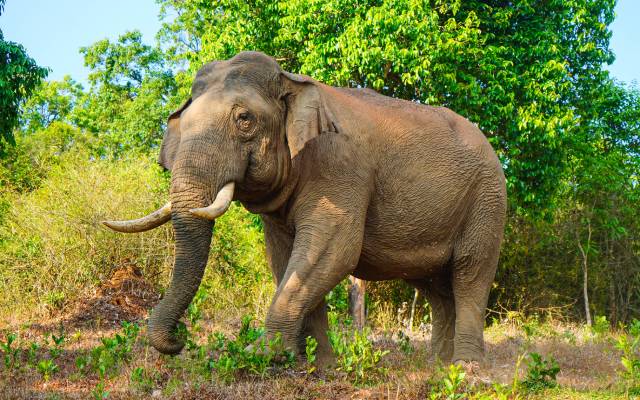West Bengal: In a heart-wrenching incident that highlights the ongoing challenges of human-elephant conflicts in India, two villagers lost their lives in a rogue elephant attack in West Bengal’s Jhargram district. The victims, identified as Ananda Jana (73) and Shashadhar Mahato (60), were residents of a village under the Nayagram Police Station. The attack, involving a distressed mother elephant, also resulted in the complete destruction of a motorcycle. This story delves into the details of the incident, the broader issue of human-elephant conflicts, and the response from local authorities.
The Elephant Attack:
The incident unfolded in a remote village when a herd of 11 elephants was in the midst of crossing the Subarnarekha River. Tragedy struck as a six-month-old baby elephant drowned during the river crossing. The mother elephant, overcome by grief and unwilling to leave the side of her deceased calf, refused to continue her journey with the rest of the herd.
The scene became more complicated when local residents began to gather near the river, drawn by the sight of the elephants. The mother elephant, still grieving and now agitated by the human presence, became increasingly aggressive. Her behavior took a deadly turn as she began charging at the people who had assembled near the river. In the process, two villagers, Ananda Jana and Shashadhar Mahato, lost their lives.
Official Response:
Shibananda Ram, the Divisional Forest Officer (DFO) of the Kharagpur division, confirmed the incident and provided insights into the situation. The DFO explained that the tragic drowning of the baby elephant during the river crossing had a profound impact on the mother elephant’s emotional state. This grief and distress appeared to have made the mother elephant aggressive and agitated, leading to the unfortunate attack on the local residents who had gathered in the area.
The DFO expressed a commitment to thoroughly investigate the incident and provide compensation to the families of the victims. The compensation, while unable to alleviate the emotional pain of the families, is aimed at offering financial support during this challenging time.
Challenges of Human-Elephant Conflict:
This incident is a grim reminder of the persistent challenges of human-elephant conflicts in various regions of India. As human populations continue to expand and encroach upon the natural habitats of elephants, interactions between humans and these gentle giants have become increasingly common. While elephants are revered in Indian culture, such interactions can sometimes lead to tragic outcomes, posing a significant challenge for both wildlife conservation and local communities.
The issue of human-elephant conflict has been a persistent concern in India, especially in states where elephant populations are significant, such as West Bengal, Assam, and Odisha. The loss of lives, damage to property, and disruption of livelihoods due to these conflicts are recurring issues faced by communities living in proximity to elephant habitats. Efforts have been underway for years to mitigate such conflicts and develop strategies for the peaceful coexistence of humans and elephants.
Conservation Efforts:
Conservation organizations and governmental bodies have been working to address human-elephant conflicts through various measures, including:
- Protected Elephant Corridors: Creating and preserving elephant corridors that allow these animals to move between fragmented habitats without entering human settlements. These corridors provide safe passageways for elephants and help reduce conflicts.
- Community Awareness: Conducting educational programs and campaigns to raise awareness among local communities about elephant behavior, the importance of conserving these animals, and safety measures during encounters.
- Crop Protection Measures: Implementing measures like elephant-proof trenches and barriers to protect agricultural fields and minimize human-elephant confrontations.
- Conflict Resolution: Developing protocols and rapid response teams to manage and mitigate conflicts when they occur, ensuring the safety of both humans and elephants.
- Humanitarian Aid: Providing support to communities affected by human-elephant conflicts, including compensation for crop damage and financial assistance in the event of loss of life or property.
- Research and Monitoring: Conducting research to better understand elephant behavior and movement patterns, which can inform conservation efforts and conflict mitigation strategies.
Conclusion:
The tragic elephant attack in West Bengal’s Jhargram district underscores the complex issue of human-elephant conflicts. The loss of two villagers in this incident is a somber reminder of the challenges faced by communities living in proximity to these magnificent creatures. Local authorities and wildlife conservationists will continue to work toward minimizing such conflicts and ensuring the safety of both humans and elephants in these regions.
The incident serves as a call to action, emphasizing the need for ongoing efforts to protect these majestic creatures and promote harmonious coexistence with local communities. While human-elephant conflicts may persist, dedicated conservation work, community engagement, and public awareness can help reduce the frequency and severity of these encounters and safeguard the lives and livelihoods of both people and elephants.

















